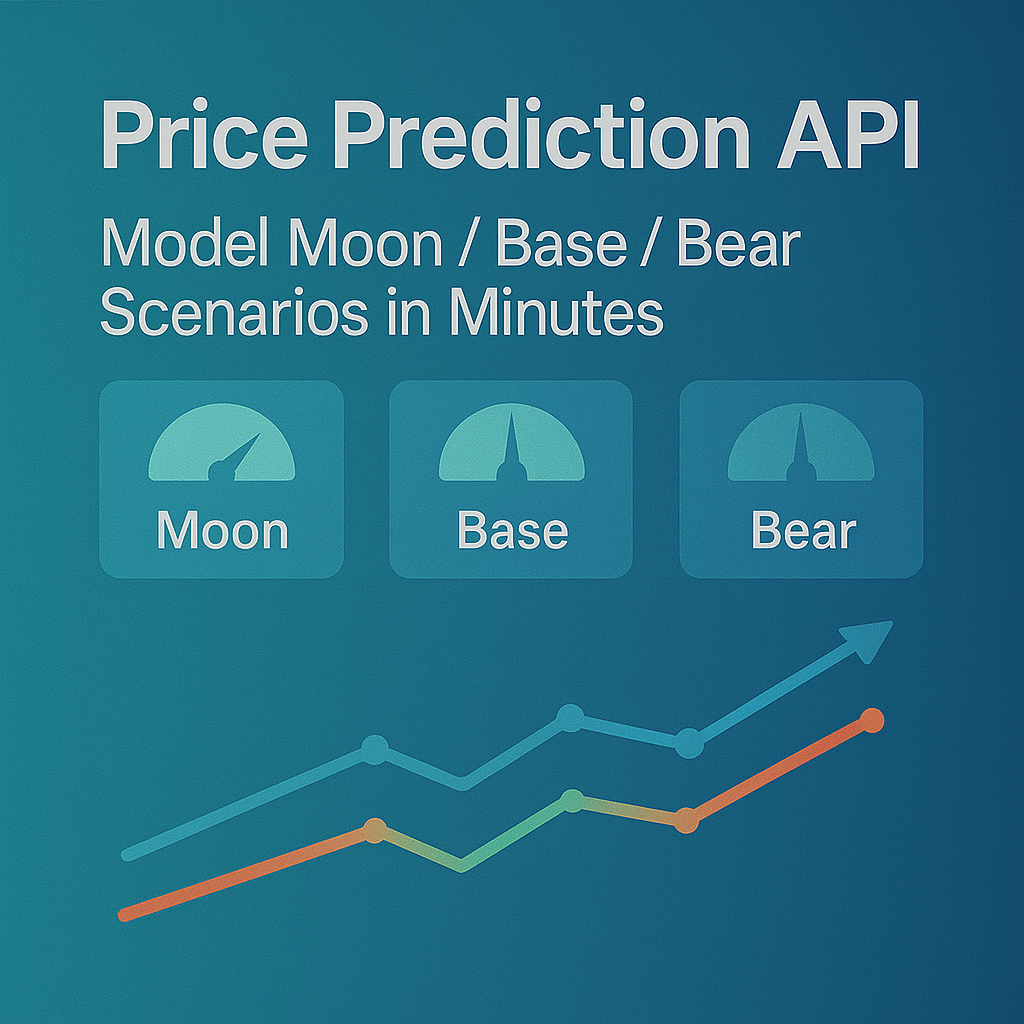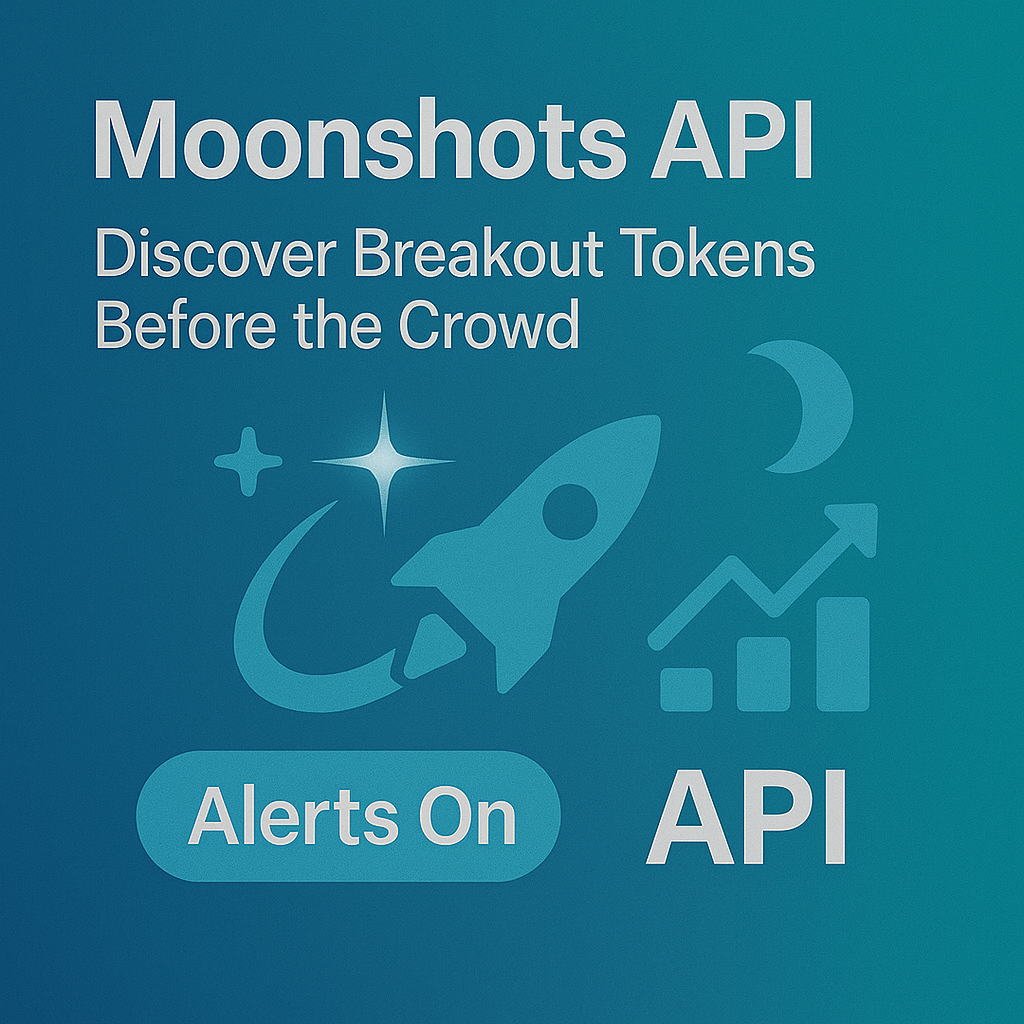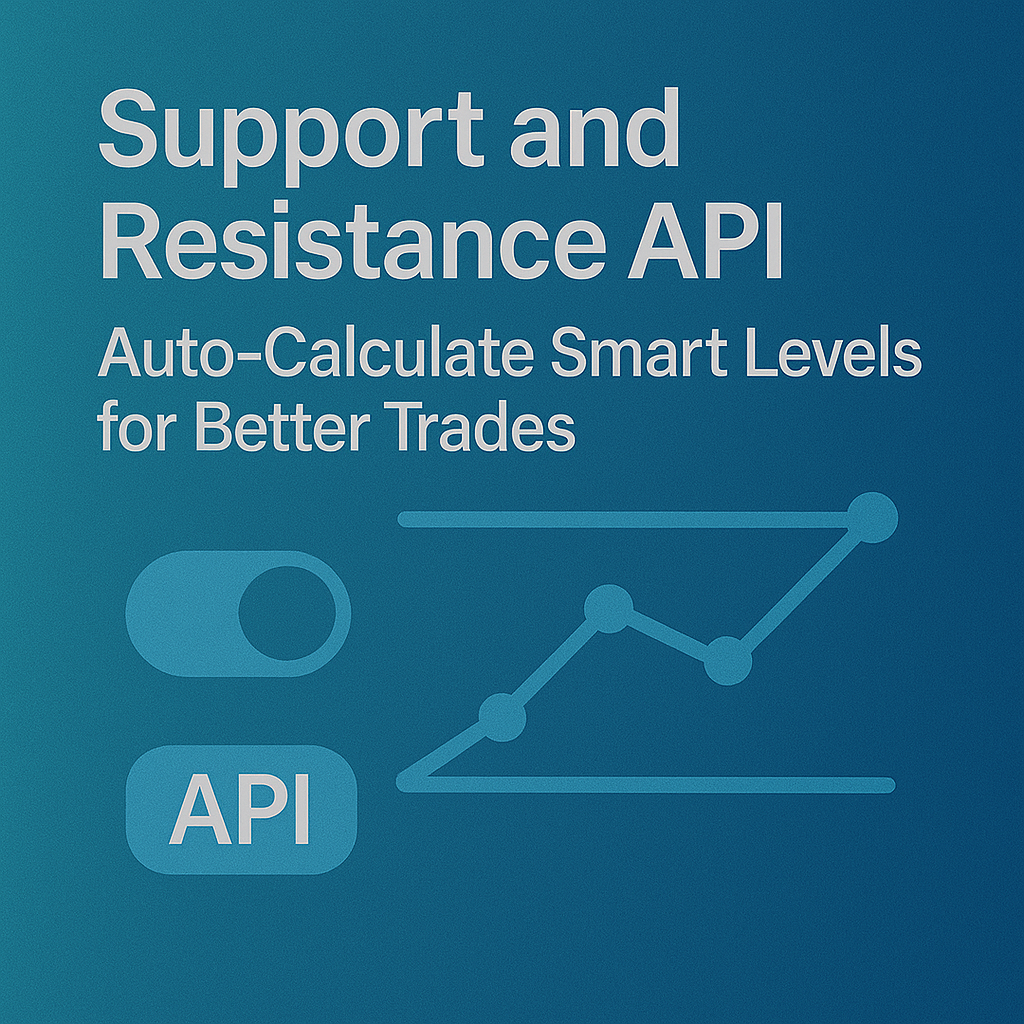Top Crypto Trading Platforms in 2025







%201.svg)
%201.svg)
Big news: We’re cranking up the heat on AI-driven crypto analytics with the launch of the Token Metrics API and our official SDK (Software Development Kit). This isn’t just an upgrade – it's a quantum leap, giving traders, hedge funds, developers, and institutions direct access to cutting-edge market intelligence, trading signals, and predictive analytics.
Crypto markets move fast, and having real-time, AI-powered insights can be the difference between catching the next big trend or getting left behind. Until now, traders and quants have been wrestling with scattered data, delayed reporting, and a lack of truly predictive analytics. Not anymore.
The Token Metrics API delivers 32+ high-performance endpoints packed with powerful AI-driven insights right into your lap, including:
Getting started with the Token Metrics API is simple:
At Token Metrics, we believe data should be decentralized, predictive, and actionable.
The Token Metrics API & SDK bring next-gen AI-powered crypto intelligence to anyone looking to trade smarter, build better, and stay ahead of the curve. With our official SDK, developers can plug these insights into their own trading bots, dashboards, and research tools – no need to reinvent the wheel.
%201.svg)
%201.svg)
The biggest gains in crypto rarely come from the majors. They come from Moonshots—fast-moving tokens with breakout potential. The Moonshots API surfaces these candidates programmatically so you can rank, alert, and act inside your product. In this guide, you’ll call /v2/moonshots, display a high-signal list with TM Grade and Bullish tags, and wire it into bots, dashboards, or screeners in minutes. Start by grabbing your key at Get API Key, then Run Hello-TM and Clone a Template to ship fast.
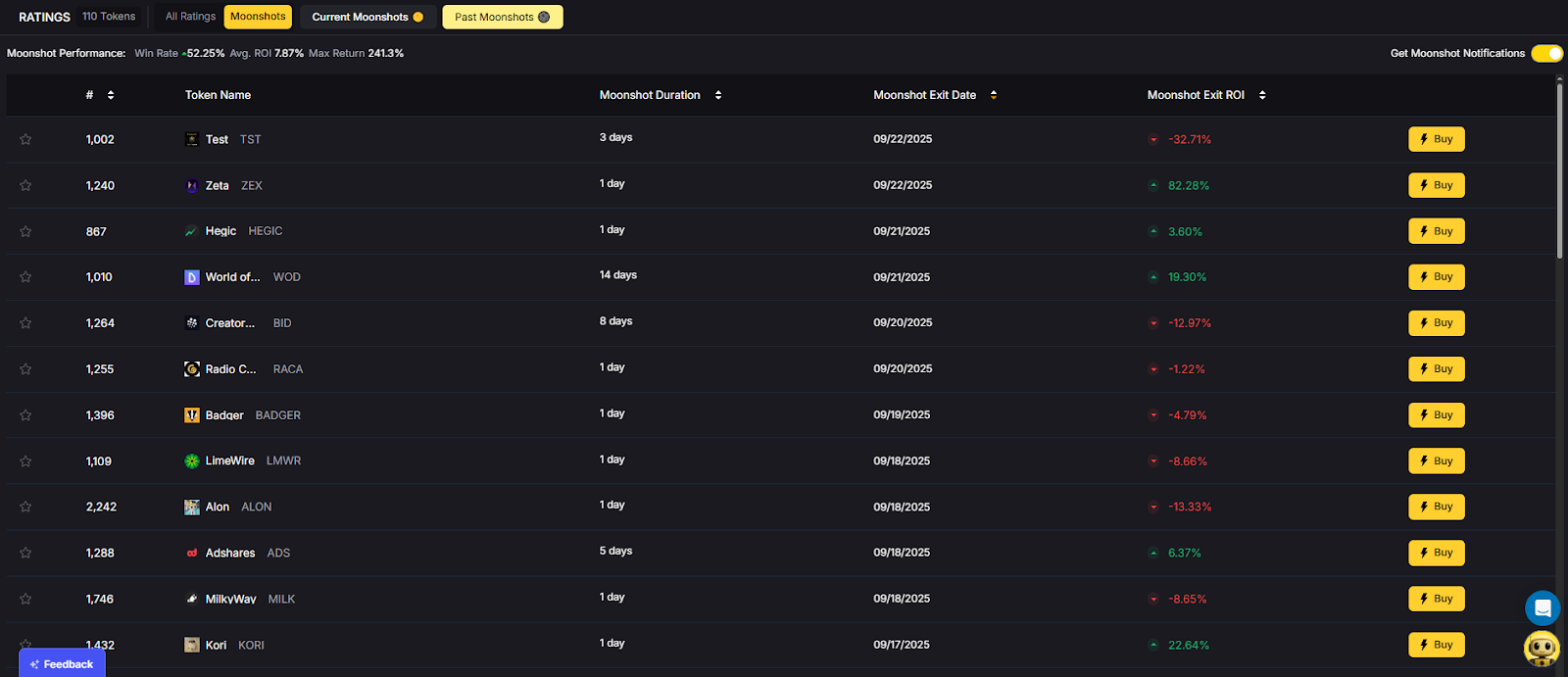
Discovery that converts. Users want more than price tickers—they want a curated, explainable list of high-potential tokens. The moonshots API encapsulates multiple signals into a short list designed for exploration, alerts, and watchlists you can monetize.
Built for builders. The endpoint returns a consistent schema with grade, signal, and context so you can immediately sort, badge, and trigger workflows. With predictable latency and clear filters, you can scale to dashboards, mobile apps, and headless bots without reinventing the discovery pipeline.
The Moonshots API cURL request is right there in the top right of the API Reference. Grab it and start tapping into the potential!
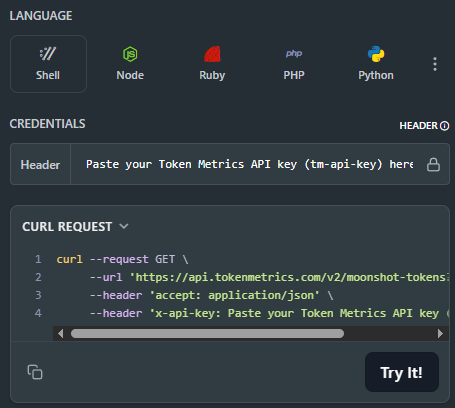
👉 Keep momentum: Get API Key • Run Hello-TM • Clone a Template
Fork a screener or alerting template, plug your key, and deploy. Validate your environment with Hello-TM. When you scale users or need higher limits, compare API plans.
The Moonshots endpoint aggregates a set of evidence—often combining TM Grade, signal state, and momentum/volume context—into a shortlist of breakout candidates. Each row includes a symbol, grade, signal, and timestamp, plus optional reason tags for transparency.
For UX, a common pattern is: headline list → token detail where you render TM Grade (quality), Trading Signals (timing), Support/Resistance (risk placement), Quantmetrics (risk-adjusted performance), and Price Prediction scenarios. This lets users understand why a token was flagged and how to act with risk controls.
Polling vs webhooks. Dashboards typically poll with short-TTL caching. Alerting flows use scheduled jobs or webhooks (where available) to smooth traffic and avoid duplicates. Always make notifications idempotent.
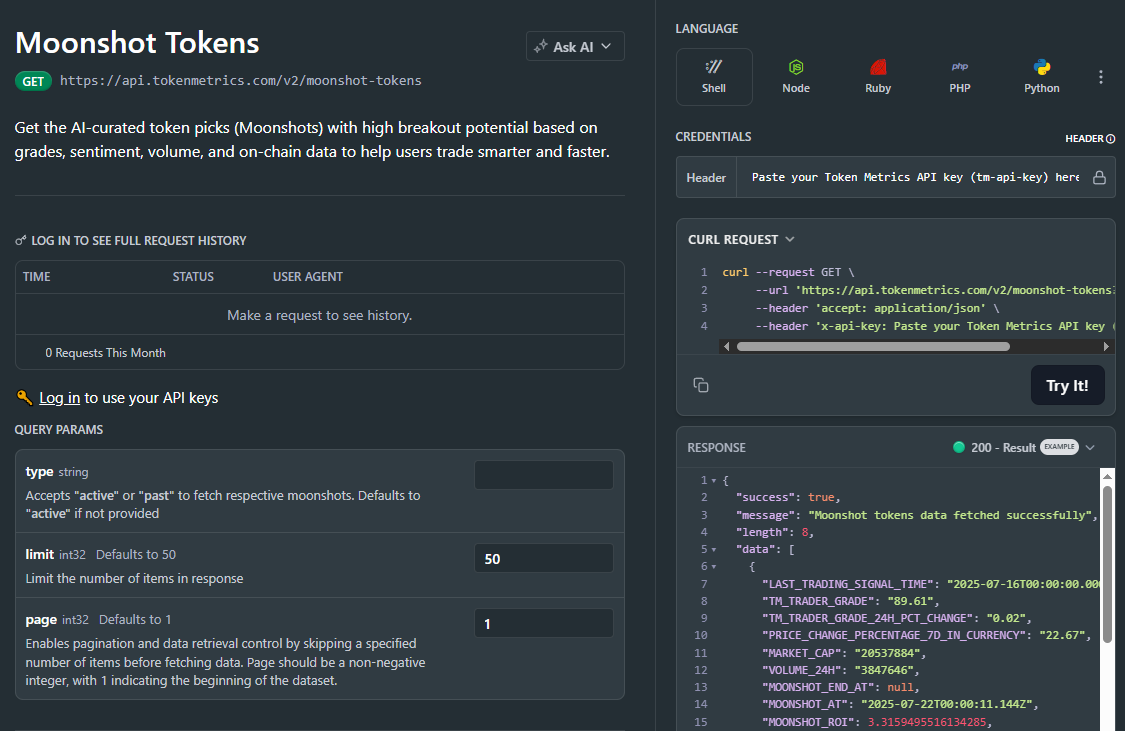
1) What does the Moonshots API return?
A list of breakout candidates with fields such as symbol, tm_grade, signal (often Bullish/Bearish), optional reason tags, and updated_at. Use it to drive discover tabs, alerts, and watchlists.
2) How fresh is the list? What about latency/SLOs?
The endpoint targets predictable latency and timely updates for dashboards and alerts. Use short-TTL caching and queued jobs/webhooks to avoid bursty polling.
3) How do I use Moonshots in a trading workflow?
Common stack: Moonshots for discovery, Trading Signals for timing, Support/Resistance for SL/TP, Quantmetrics for sizing, and Price Prediction for scenario context. Always backtest and paper-trade first.
4) I saw results like “+241%” and a “7.5% average return.” Are these guaranteed?
No. Any historical results are illustrative and not guarantees of future performance. Markets are risky; use risk management and testing.
5) Can I filter the Moonshots list?
Yes—pass parameters like min_grade, signal, and limit (as supported) to tailor to your audience and keep pages fast.
6) Do you provide SDKs or examples?
REST works with JavaScript and Python snippets above. Docs include quickstarts, Postman collections, and templates—start with Run Hello-TM.
7) Pricing, limits, and enterprise SLAs?
Begin free and scale up. See API plans for rate limits and enterprise options.
%201.svg)
%201.svg)
Most traders still draw lines by hand in TradingView. The support and resistance API from Token Metrics auto-calculates clean support and resistance levels from one request, so your dashboard, bot, or alerts can react instantly. In minutes, you’ll call /v2/resistance-support, render actionable levels for any token, and wire them into stops, targets, or notifications. Start by grabbing your key on Get API Key, then Run Hello-TM and Clone a Template to ship a production-ready feature fast.
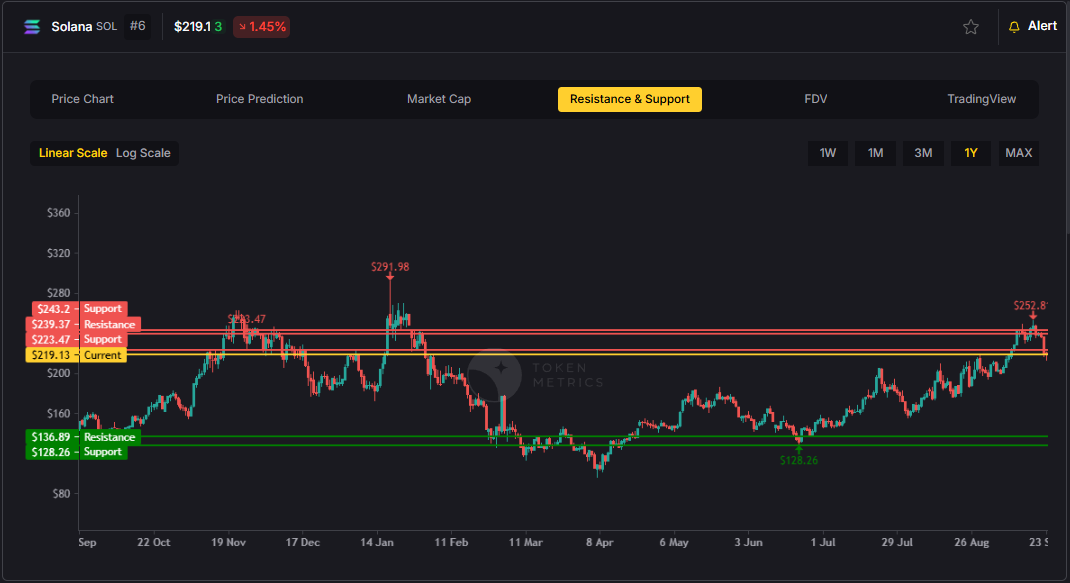
Precision beats guesswork. Hand-drawn lines are subjective and slow. The support and resistance API standardizes levels across assets and timeframes, enabling deterministic stops and take-profits your users (and bots) can trust.
Production-ready by design. A simple REST shape, predictable latency, and clear semantics let you add levels to token pages, automate SL/TP alerts, and build rule-based execution with minimal glue code.
Need the Support and Resistance data? The cURL request for it is in the top right of the API Reference for quick access.
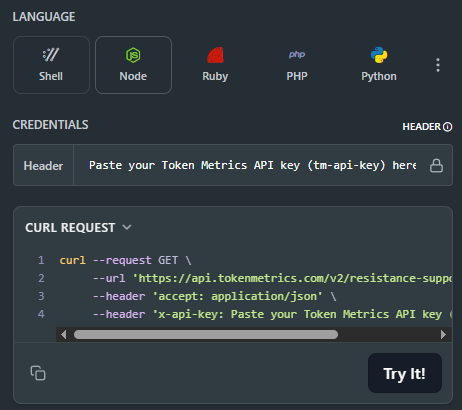
👉 Keep momentum: Get API Key • Run Hello-TM • Clone a Template
Kick off with our quickstarts—fork a bot or dashboard template, plug your key, and deploy. Confirm your environment by Running Hello-TM. When you’re scaling or need webhooks/limits, review API plans.
The Support/Resistance endpoint analyzes recent price structure to produce discrete levels above and below current price, along with strength indicators you can use for priority and styling. Query /v2/resistance-support?symbol=<ASSET>&timeframe=<HORIZON> to receive arrays of level objects and timestamps.
Polling vs webhooks. For dashboards, short-TTL caching and batched fetches keep pages snappy. For bots and alerts, use queued jobs or webhooks (where applicable) to avoid noisy, bursty polling—especially around market opens and major events.
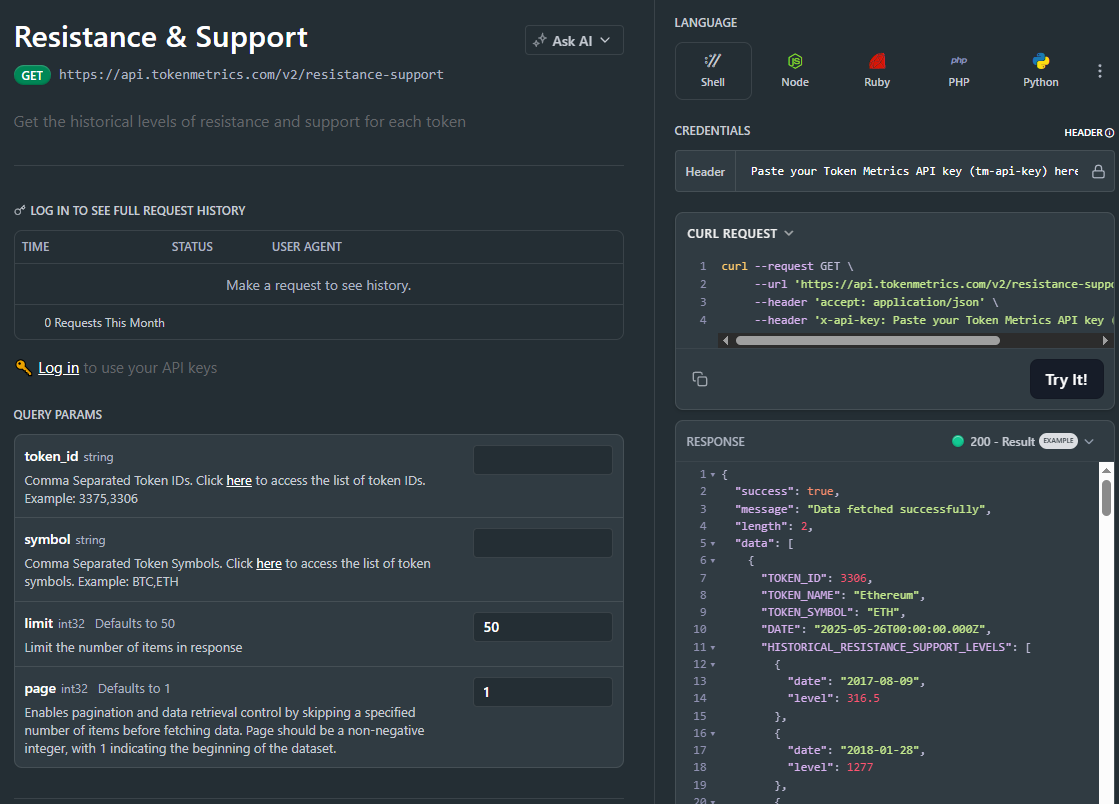
1) What does the Support & Resistance API return?
A JSON payload with arrays of support and resistance levels for a symbol (and optional timeframe), each with a price and strength indicator, plus an update timestamp.
2) How timely are the levels? What are the latency/SLOs?
The endpoint targets predictable latency suitable for dashboards and alerts. Use short-TTL caching for UIs, and queued jobs or webhooks for alerting to smooth traffic.
3) How do I trigger alerts or trades from levels?
Common patterns: alert when price is within X% of a level, touches a level, or breaks beyond with confirmation. Always make downstream actions idempotent and respect rate limits.
4) Can I combine levels with other endpoints?
Yes—pair with /v2/trading-signals for timing, /v2/tm-grade for quality context, and /v2/quantmetrics for risk sizing. This yields a complete decide-plan-execute loop.
5) Which timeframe should I use?
Intraday bots prefer shorter horizons; swing/position dashboards use daily or higher-timeframe levels. Offer a timeframe toggle and cache results per setting.
6) Do you provide SDKs or examples?
Use the REST snippets above (JS/Python). The docs include quickstarts, Postman collections, and templates—start with Run Hello-TM.
7) Pricing, limits, and enterprise SLAs?
Begin free and scale as you grow. See API plans for rate limits and enterprise SLA options.
%201.svg)
%201.svg)
Most traders see price—quants see probabilities. The Quantmetrics API turns raw performance into risk-adjusted stats like Sharpe, Sortino, volatility, drawdown, and CAGR so you can compare tokens objectively and build smarter bots and dashboards. In minutes, you’ll query /v2/quantmetrics, render a clear performance snapshot, and ship a feature that customers trust. Start by grabbing your key at Get API Key, Run Hello-TM to verify your first call, then Clone a Template to go live fast.
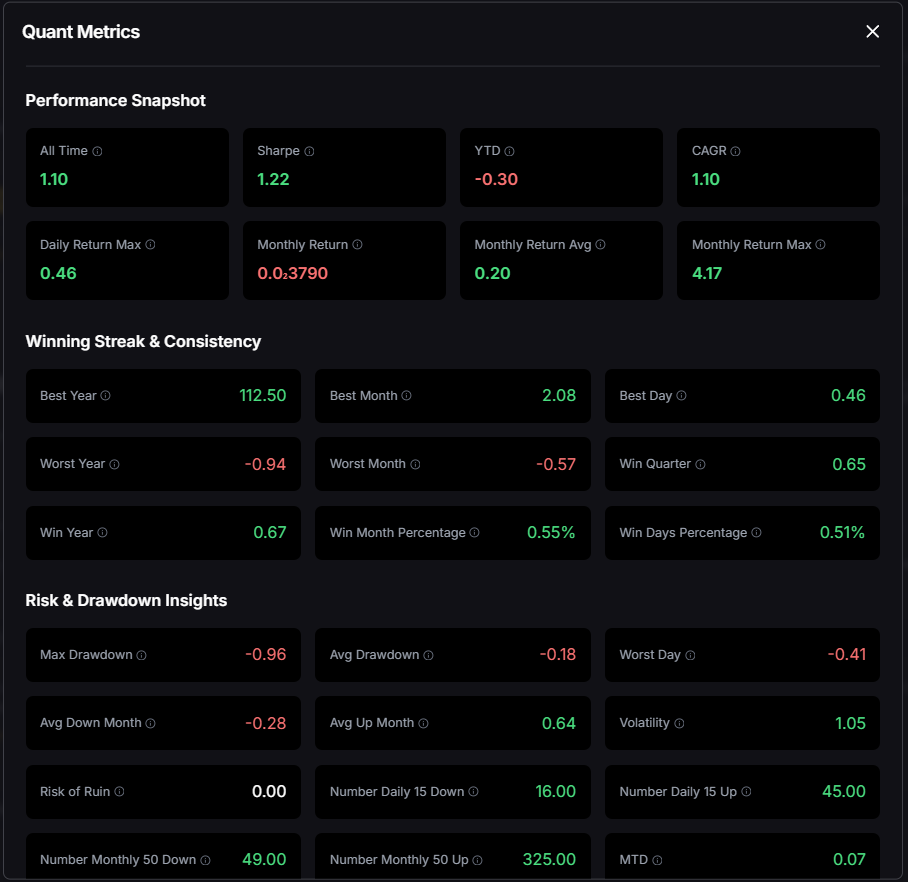
Risk-adjusted truth beats hype. Price alone hides tail risk and whipsaws. Quantmetrics compresses edge, risk, and consistency into metrics that travel across assets and timeframes—so you can rank universes, size positions, and communicate performance like a pro.
Built for dev speed. A clean REST schema, predictable latency, and easy auth mean you can plug Sharpe/Sortino into bots, dashboards, and screeners without maintaining your own analytics pipeline. Pair with caching and batching to serve fast pages at scale.
The Quant Metrics cURL request is located in the top right of the API Reference, allowing you to easily integrate it with your application.
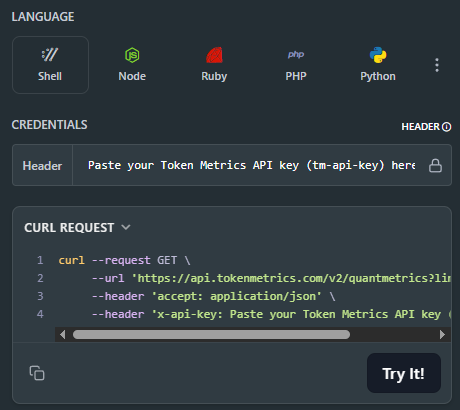
👉 Keep momentum: Get API Key • Run Hello-TM • Clone a Template
Kick off from quickstarts in the docs—fork a dashboard or screener template, plug your key, and deploy in minutes. Validate your environment with Run Hello-TM; when you need more throughput or webhooks, compare API plans.
Quantmetrics computes risk-adjusted performance over a chosen lookback (e.g., 30d, 90d, 1y). You’ll receive a JSON snapshot with core statistics:
Call /v2/quantmetrics?symbol=<ASSET>&window=<LOOKBACK> to fetch the current snapshot. For dashboards spanning many tokens, batch symbols and apply short-TTL caching. If you generate alerts (e.g., “Sharpe crossed 1.5”), run a scheduled job and queue notifications to avoid bursty polling.
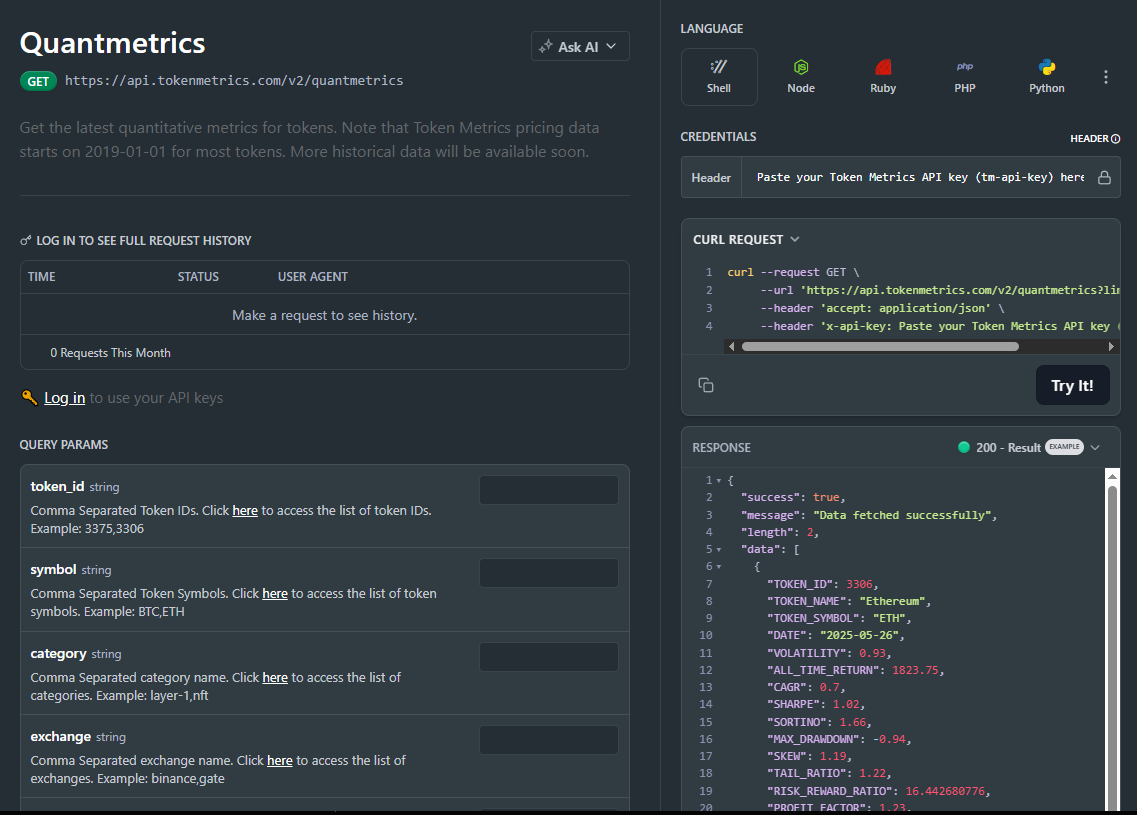
1) What does the Quantmetrics API return?
A JSON snapshot of risk-adjusted metrics (e.g., Sharpe, Sortino, volatility, max drawdown, CAGR) for a symbol and lookback window—ideal for ranking, sizing, and dashboards.
2) How fresh are the stats? What about latency/SLOs?
Responses are engineered for predictable latency. For heavy UI usage, add short-TTL caching and batch requests; for alerts, use scheduled jobs or webhooks where available.
3) Can I use Quantmetrics to size positions in a live bot?
Yes—many quants size inversely to volatility or require Sharpe ≥ X to trade. Always backtest and paper-trade before going live; past results are illustrative, not guarantees.
4) Which lookback window should I choose?
Short windows (30–90d) adapt faster but are noisier; longer windows (6–12m) are steadier but slower to react. Offer users a toggle and cache each window.
5) Do you provide SDKs or examples?
REST is straightforward (JS/Python above). Docs include quickstarts, Postman collections, and templates—start with Run Hello-TM.
6) Polling vs webhooks for quant alerts?
Dashboards usually use cached polling. For threshold alerts (e.g., Sharpe crosses 1.0), run scheduled jobs and queue notifications to keep usage smooth and idempotent.
7) Pricing, limits, and enterprise SLAs?
Begin free and scale up. See API plans for rate limits and enterprise SLA options.

%201.svg)
%201.svg)
APIs power much of the digital world but the term can feel abstract to newcomers. Whether you are building a web app, integrating an AI model, or pulling market data for research, understanding what an API is and how to evaluate one speeds development and improves reliability. This guide breaks down core concepts, common patterns, and practical steps to choose and use APIs effectively—without assuming prior expertise.
An API (Application Programming Interface) is a defined set of rules and protocols that lets one software program request services or data from another. At a high level, an API specifies:
Think of an API as a waitstaff in a restaurant: you (the client) place an order (request) using a menu (API documentation), and the kitchen (server) returns a dish (response). The menu defines what is possible and how to order it.
APIs come in different styles depending on design goals and constraints:
Each type has trade-offs: REST is simple and widely compatible, GraphQL is flexible for variable payloads, and gRPC is optimized for performance between services.
APIs are central to modern crypto and AI stacks. In crypto, APIs provide access to market prices, on-chain data, wallet balances, and transaction histories. In AI, APIs expose model inference endpoints, allowing applications to send prompts and receive processed outputs without hosting models locally.
When connecting these domains—such as feeding on-chain data into an AI research pipeline—developers use layered APIs: one service to fetch reliable market or chain data, another to run models or scoring logic. For example, research platforms and data providers expose standardized endpoints so teams can automate backtesting, signal generation, and analytics workflows.
For neutral examples of an analytics provider in the crypto space, see Token Metrics, which demonstrates how specialized APIs and models can structure insights for research use cases.
Choosing and integrating an API is a mix of technical evaluation and operational planning. Use this checklist:
Applying this framework helps teams decide between alternatives (self-hosting vs managed, REST vs GraphQL) based on their latency, cost, and control needs.
Build Smarter Crypto Apps & AI Agents with Token Metrics
Token Metrics provides real-time prices, trading signals, and on-chain insights all from one powerful API. Grab a Free API Key
An API is a set of rules for interacting with a service, typically over a network. An SDK (Software Development Kit) is a package that may include APIs, helper libraries, and tools to make integrating those APIs easier in a specific programming language.
REST maps resources to endpoints and is simple to cache and reason about. GraphQL lets clients request only needed fields and combine multiple resources in one query, which can reduce round trips but may add server-side complexity.
Public APIs can be secure if they implement proper authentication, encryption, and access controls. Avoid sending sensitive secrets through unencrypted channels and use scoped credentials and least-privilege principles.
Rate limits cap how many requests a client can make in a time window. Design strategies include batching requests, caching responses, exponential backoff on errors, and choosing higher-tier plans if sustained throughput is required.
Yes. Orchestration patterns let you fetch data from one API, transform it, and pass it to another (for example, pulling market data into an AI inference pipeline). Maintain clear error handling and data validation between steps.
Use sandbox or staging environments when possible, write automated tests for expected responses and error states, monitor real-world requests, and include assertions for schema and performance thresholds.
Common methods include API keys, OAuth 2.0 tokens, and mutual TLS. Select a method that balances ease of use and security for your application's context.
This article is educational and informational only. It does not constitute financial, legal, or professional advice. Evaluate APIs and tools independently, review provider terms, and consider operational and security requirements before integration.

%201.svg)
%201.svg)
APIs (Application Programming Interfaces) are the invisible connectors that let software systems talk to each other. Whether you open a weather app, embed a payment form, or fetch crypto market data, APIs are doing the behind-the-scenes work. This guide explains what an API is, how APIs function, common types, practical use cases, and how to evaluate them securely and effectively.
An API is a defined set of rules and protocols that allows one software component to request services or data from another. Think of an API as a waiter in a restaurant: you (the client) request a dish, the waiter (the API) passes the order to the kitchen (the server), and then returns the prepared meal. APIs standardize interactions so developers can integrate external functionality without understanding internal implementation details.
At a technical level, most modern APIs use web protocols over HTTP/HTTPS. A client sends a request (GET, POST, PUT, DELETE) to a defined endpoint URL. The server processes the request, optionally interacts with databases or other services, and returns a response, often in JSON or XML format. Key components:
APIs come in several architectural styles and transport patterns. Understanding differences helps pick the right integration model.
In crypto and AI contexts, APIs are central to tooling and research workflows:
AI-driven research platforms and analytics services can combine multiple API feeds to produce indicators, signals, or summaries. Platforms like Token Metrics illustrate how aggregated datasets and models can be exposed via APIs to power decision-support tools.
Before integrating an API, apply a simple due-diligence framework:
APIs introduce attack surfaces. Adopt defensive measures:
Build Smarter Crypto Apps & AI Agents with Token Metrics
Token Metrics provides real-time prices, trading signals, and on-chain insights all from one powerful API. Grab a Free API Key
Q: What is the simplest way to describe an API?
A: An API is an interface that defines how software components communicate—standardized requests and responses that let systems share data and functionality.
Q: When should I use REST vs WebSocket or GraphQL?
A: REST is suitable for standard CRUD operations. WebSocket is appropriate for real-time bidirectional needs like live feeds. GraphQL is useful when clients need flexible queries to minimize data transfer.
Q: What are common API security concerns?
A: Major concerns include credential leakage, insufficient authorization, unencrypted transport, and abuse due to inadequate rate limiting. Following best practices reduces these risks.
Q: Are free APIs viable for production?
A: Free tiers can be useful for prototypes and low-traffic apps, but evaluate limits, reliability, and support before relying on them for critical production workloads.
Q: What factors matter most when selecting an API?
A: Prioritize data relevance, latency, reliability, documentation quality, security controls, and cost. Prototype early to validate assumptions about performance and coverage.
This article is educational and informational only. It does not provide financial, legal, or investment advice. Evaluate tools and services independently and consult professionals where appropriate.

%201.svg)
%201.svg)
APIs are the invisible glue connecting modern software — from mobile apps and cloud services to AI agents and crypto dashboards. Understanding what an API is, how it works, and how to evaluate one is essential for builders, analysts, and product managers who need reliable data and interoperable systems. This guide breaks down APIs into practical components, shows common real-world use cases, and outlines security and integration best practices without jargon.
API stands for "Application Programming Interface." At its core, an API is a contract between two software systems that defines how they exchange information. Instead of sharing raw databases or duplicating functionality, systems expose endpoints (URL patterns or function calls) that clients can use to request specific data or actions.
APIs matter because they enable modularity and reuse. Developers can consume services—such as authentication, payments, mapping, or market data—without rebuilding them. For example, a crypto portfolio app might fetch price feeds, on-chain metrics, and historical candles via multiple APIs rather than maintaining every data pipeline internally.
APIs also power automation and AI: machine learning models and AI agents frequently call APIs to retrieve fresh data, trigger workflows, or enrich decision-making pipelines. Tools like Token Metrics use APIs to combine price feeds, signals, and on-chain indicators into research products.
Most web APIs follow a simple request–response pattern over HTTP(S). A client sends a request to an endpoint and receives a response containing status information and payload data. Key elements to understand:
Understanding these primitives helps teams design robust clients: retry logic for transient errors, pagination for large datasets, and schema validation for payload integrity.
APIs come in several flavors depending on their design and purpose. Recognizing the differences helps you pick the right integration model.
Use-case examples:
When integrating any external API, consider availability and trustworthiness alongside features. Key operational and security practices include:
Selecting the right provider often requires scenario analysis: trade off latency vs. cost, historical depth vs. real-time freshness, and breadth of endpoints vs. ease of use. Well-documented APIs with client SDKs, clear versioning, and robust support reduce integration risk.
Build Smarter Crypto Apps & AI Agents with Token Metrics
Token Metrics provides real-time prices, trading signals, and on-chain insights all from one powerful API. Grab a Free API Key
Q1: What’s the difference between an API and a web service?
An API is a broader concept: a set of rules for interacting with software. A web service is a type of API that specifically uses web protocols (HTTP) to exchange data between systems.
Authentication methods vary: API keys for simple use cases, OAuth for delegated access, or HMAC signatures for high-security endpoints. Always follow the provider’s recommended flow and protect credentials.
GraphQL is useful when clients need flexible queries and should avoid over- or under-fetching. REST is simpler and often sufficient for straightforward resource-based designs. Choose based on data complexity and client requirements.
Rate limits control how many requests you can make in a given window. Plan batching, caching, and backoff strategies to stay within limits while maintaining performance and reliability.
Yes. Real-time needs are typically met with WebSocket or streaming APIs that push updates to clients. Polling REST endpoints frequently is possible but less efficient and may hit rate limits.
Look at documentation quality, authentication options, latency, historical data availability, SDKs, support channels, and uptime history. Proof-of-concept integrations and small-scale performance tests reveal practical fit.
This article is educational and informational only. It does not constitute financial, legal, or investment advice. Evaluate APIs and providers based on your organization’s technical requirements, compliance needs, and risk tolerance before integrating.

%201.svg)
%201.svg)
APIs power modern software by letting systems talk to one another. Whether you use a mobile app, connect a trading bot, or plug an AI model into a data feed, APIs are the plumbing that moves data and requests. This guide explains what an API is, how APIs work, common types and protocols, practical crypto and AI use cases, and design and security practices you should know as a developer or analyst.
API stands for Application Programming Interface. Broadly, it is a contract that defines how one software component requests services or data from another. An API specifies:
At runtime a client (for example, a web app) sends a request to an API endpoint on a server. The server validates the request, executes logic, and returns a response—usually structured data like JSON or XML. Think of an API as a standardized messenger that abstracts internal complexity and enforces clear expectations between systems.
APIs differ by style and protocol. Key varieties include:
Protocol selection depends on latency, payload size, developer ergonomics, and whether the API is public, private, or internal to an organization.
APIs are foundational in crypto and AI workflows. Examples include:
For teams building crypto analytics or AI agents, structured and timely data is essential. For example, Token Metrics provides research tools that combine on-chain and market signals behind an API-friendly interface, illustrating how analytics platforms expose data and insights for downstream tools.
Robust API design balances usability, performance, and safety. Key best practices include:
Security is especially important for crypto-related endpoints that can expose sensitive account or on-chain actions. Design your API assuming adversaries will attempt to abuse endpoints and validate responses on the client side as well.
Build Smarter Crypto Apps & AI Agents with Token Metrics
Token Metrics provides real-time prices, trading signals, and on-chain insights all from one powerful API. Grab a Free API Key
An API defines how to communicate with a service; a library is code you include in a project. An SDK bundles libraries, documentation, and tools to help developers use an API more easily.
REST exposes fixed endpoints for resources and often returns entire objects, while GraphQL lets clients specify exact fields to fetch. GraphQL can reduce data transfer for complex UIs but adds server-side complexity.
Public APIs can be used in production if they meet reliability, latency, and security requirements. Verify SLAs, implement retries and fallbacks, and isolate credentials using secure storage patterns.
Common methods include API keys, OAuth 2.0, JWTs, and signed requests. Choose mechanisms that match your threat model: short-lived tokens and scoped keys reduce exposure compared to long-lived secrets.
Use unit and integration tests with mocked responses, postman or curl for ad-hoc tests, and observability tools to monitor latency, error rates, and unexpected schema changes. Deploy health checks and alarming for critical endpoints.
Rate limits vary by provider; common patterns include requests-per-minute and burst allowances. Clients should implement exponential backoff, respect Retry-After headers, and cache responses where appropriate.
APIs supply structured, machine-readable data that AI agents can ingest for feature generation, state tracking, or decision-making. Consistent schemas, timestamps, and low-latency endpoints improve model reliability.
APIs are the connective tissue of modern software, enabling modular design, data sharing, and integration across web, crypto, and AI systems. Understanding API types, security practices, and operational patterns helps teams design robust integrations and choose the right tooling for scale.
This article is for educational purposes only. It provides technical explanations and practical guidance about APIs and related technologies. It does not constitute investment, legal, or professional advice.

%201.svg)
%201.svg)
APIs are one of the least visible yet most powerful pieces of modern software infrastructure. Whether you're building a mobile app, connecting to market data, or integrating an AI model, APIs are the bridges that let systems share data and functionality. This guide unpacks what an API is, how different API styles work, and practical steps to evaluate and use APIs safely and effectively.
An API—short for Application Programming Interface—is a set of rules and protocols that lets one software system request services or data from another. At its simplest, an API specifies the inputs a caller must provide, the format of those inputs, and the shape of the output it can expect. APIs abstract internal implementation details so developers can build on top of existing services without reinventing core functionality.
Key conceptual elements include:
At a technical level, most modern APIs follow a request-response model. A client sends a request to an endpoint, the server processes that request using internal logic or data stores, and then returns a response. The most common flow includes:
APIs also include non-functional considerations: latency, consistency, error handling, and observability. Robust APIs document error codes, expected payloads, and examples to reduce integration friction.
Not all APIs are the same. Choosing the right style depends on use case, performance needs, and complexity.
In crypto and AI contexts, combinations are common: REST for configuration and historical data, WebSocket for live updates, and specialized RPC endpoints for blockchain node interactions.
APIs are used to access market data, execute trades (in regulated contexts), fetch on-chain metrics, call ML inference endpoints, and orchestrate microservices. When evaluating or integrating an API, consider:
For teams building AI agents or analytic dashboards, designing APIs with predictable schemas and clear versioning reduces downstream friction. AI-driven research platforms can augment manual analysis by normalizing data and providing signal overlays; for example, tools like Token Metrics integrate multiple data sources and can be accessed via APIs to feed models or dashboards.
Build Smarter Crypto Apps & AI Agents with Token Metrics
Token Metrics provides real-time prices, trading signals, and on-chain insights all from one powerful API. Grab a Free API Key
Q: How is an API different from a library or SDK?
A: A library is code included in an application at compile/runtime and runs locally; an SDK bundles libraries and tools for a platform. An API is an interface—often remote—that defines how to interact with a service that may run on different infrastructure.
Q: How should I secure API access?
A: Use strong authentication (tokens, OAuth), enforce least privilege, rotate keys, use TLS for transport encryption, validate inputs server-side, and monitor usage for anomalies.
Q: Why do APIs throttle requests?
A: Rate limits protect service stability, prevent abuse, and ensure fair access. Design clients to respect published limits and apply exponential backoff on failures.
Q: What approaches are used for versioning?
A: Common patterns: URL versioning (/v1/...), header-based versioning, or content negotiation. Versioning maintains backward compatibility and lets providers evolve interfaces without breaking clients.
Q: REST, GraphQL, or WebSocket—how to decide?
A: Choose REST for straightforward resource access and broad compatibility, GraphQL when clients need flexible queries to minimize payloads, and WebSocket for real-time streaming or low-latency updates.
This article is for informational purposes only and does not constitute financial, legal, or professional advice. It outlines technical concepts and best practices for understanding and integrating APIs. Evaluate services and compliance considerations independently before sending or acting on production data.

%201.svg)
%201.svg)
APIs power much of the modern software economy, but the term can feel abstract. This guide breaks down what an API is, how APIs work in practice, common types you’ll encounter, and practical frameworks for evaluating or integrating an API into your projects.
An API, or application programming interface, is a set of rules and protocols that lets different software components communicate. Think of an API as a contract: one system exposes specific operations (endpoints) and data structures, and other systems call those operations to request services or information. The API hides internal complexity and provides a predictable interface for developers.
At its core, an API specifies:
APIs can be implemented with different technologies, but common patterns include REST, GraphQL, and RPC (gRPC). A typical web API flow involves a client sending an HTTP request to an endpoint URL, the server processing that request, and then returning a structured response. Key components to understand:
Understanding these pieces helps you design predictable integrations and debug issues like unexpected latencies or malformed responses.
Different APIs serve different needs. Here are common categories and examples:
Practical examples: integrating a payment processor via its REST API, pulling exchange rates from a crypto API for display, or using a mapping API to embed location features.
When researching or choosing an API, apply a short framework: compatibility, cost, reliability, and security (CCRS).
Additional integration tips: use sandbox environments for testing, log API requests/responses for troubleshooting, and build retry/backoff logic to handle transient failures.
Build Smarter Crypto Apps & AI Agents with Token Metrics
Token Metrics provides real-time prices, trading signals, and on-chain insights all from one powerful API. Grab a Free API Key
REST defines endpoints that return fixed data structures, which can result in over- or under-fetching. GraphQL exposes a query language where clients request exactly the fields they need, reducing extra data transfer but adding schema complexity on the server side.
API keys are simple credentials often used for server-to-server authentication or identifying an app. OAuth is an authorization framework that enables delegated access (user consents) and typically issues short-lived access tokens with refresh mechanics for better security.
No. Security depends on implementation: use HTTPS, validate and sanitize inputs, enforce proper authentication/authorization, rotate keys periodically, and monitor for unusual activity. Treat APIs as a potential attack surface and apply standard security controls.
Rate limits vary widely: some services allow thousands of requests per minute, others are stricter. Implement client-side throttling, exponential backoff on retries, and caching where appropriate to reduce request volume and avoid hitting limits.
AI-driven tools can help parse API responses, detect anomalies, prioritize endpoints by value, and synthesize insights from multiple data feeds. Platforms such as Token Metrics use AI to aggregate on-chain and market data, which can speed evaluation when integrating crypto-related APIs.
Common issues include unexpected breaking changes, insufficient error handling, underestimating rate limits, hidden costs, and lack of observability. Mitigate these by reading docs thoroughly, using versioned endpoints, and automating monitoring and alerts.
Disclaimer: This article is for educational and informational purposes only. It explains technical concepts and practical frameworks related to APIs and does not provide investment, legal, or professional advice. Evaluate services independently and consult appropriate experts for decision-making.

%201.svg)
%201.svg)
APIs — short for Application Programming Interfaces — are the invisible wiring that connects software, data, and services. From mobile apps fetching weather to crypto platforms streaming on-chain data, APIs turn discrete systems into interoperable ecosystems. This guide explains what an API is, how it works, common types and protocols, practical evaluation criteria, and how AI-driven tools can help you research and integrate APIs safely and effectively.
An API is a set of rules and conventions that lets one software program request services or data from another. Think of it as a contract: the provider exposes endpoints and documented inputs/outputs, and the consumer sends requests and receives structured responses. APIs abstract complexity, enforce consistency, and enable modular development.
At a high level, an API specifies:
Most modern web APIs operate over HTTP. A consumer makes a request to a URL (endpoint) using an HTTP method such as GET, POST, PUT, or DELETE. The server processes the request and returns a response payload plus status codes that signal success or error.
Core concepts:
Understanding these mechanics helps you design integrations, debug issues, and interpret API documentation efficiently.
Not all APIs are built the same. Choosing the right style depends on use case, performance needs, and client ecosystem.
Each approach has trade-offs: REST is simple but may require multiple round-trips, GraphQL reduces over-fetching but adds server complexity, and WebSockets enable streaming but require connection management.
APIs often provide access to valuable data and functionality, so security and governance are paramount. Key considerations include:
Operational SLAs, clear error codes, and robust documentation reduce integration friction and surface potential risks early.
When assessing a third-party API, use a structured framework:
For proofs of concept, use API testing tools (Postman, curl) and programmatic SDKs where available. Track metrics during integration and plan for retries, backoff strategies, and graceful degradation.
Build Smarter Crypto Apps & AI Agents with Token Metrics
Token Metrics provides real-time prices, trading signals, and on-chain insights all from one powerful API. Grab a Free API Key
An API (Application Programming Interface) is a defined set of rules and endpoints that allows one software system to request data or services from another. It standardizes how data is exchanged and operations are invoked between systems.
REST is simple and widely supported, ideal for straightforward resource-based access. GraphQL excels when clients need flexible, aggregated queries and want to reduce over-fetching. Choice depends on client needs and server complexity tolerance.
Security relies on strong authentication (API keys, OAuth), encryption (HTTPS/TLS), authorization controls, rate limiting, input validation, and monitoring. Regular audits and threat modeling help identify and mitigate risks.
APIs power mobile and web apps, payment processing, identity providers, data feeds (market, weather, maps), IoT device control, and integrations between enterprise systems or blockchain nodes.
Use sandbox environments and test keys where available. Employ tools like Postman for exploratory testing, write automated integration tests, validate edge cases and error handling, and verify rate-limit behaviors under load.
This article is for educational and informational purposes only. It explains technical concepts and evaluation frameworks but does not constitute professional, legal, or investment advice. Always perform your own due diligence when selecting or integrating APIs.

%201.svg)
%201.svg)
APIs sit at the center of modern software. Whether a mobile app fetches weather data, a dashboard queries on-chain activity, or an AI agent calls a language model, an API is the bridge that enables machines to communicate. This article breaks down what an API is, how it works, common types and use cases, and practical steps to evaluate and use one safely and effectively.
An API (Application Programming Interface) is a defined set of rules and protocols that allow software components to communicate. It specifies the methods available, the expected inputs and outputs, and the underlying conventions for transport and encoding. In web development, APIs typically include endpoints you can call over HTTP, request and response formats (commonly JSON), and authentication rules.
Think of an API as a contract: the provider promises certain functionality (data, computations, actions) and the consumer calls endpoints that adhere to that contract. Examples include a weather API returning forecasts, a payment API creating transactions, or a blockchain data API exposing balances and transactions.
At a technical level, most web APIs follow simple request/response patterns:
Key concepts to understand:
APIs come in many shapes tailored to different needs:
Use cases span industries: integrating payment gateways, building mobile backends, connecting to cloud services, feeding analytics dashboards, and powering crypto tools that stream price, order book, and on-chain data. AI systems also consume APIs—calling models for text generation, embeddings, or specialized analytics.
Whether you are a developer integrating an API or evaluating a provider, use a systematic approach:
For domain-specific APIs, such as those powering crypto analytics or trading signals, additional considerations include data freshness, source transparency (e.g., direct node reads vs. indexers), and on-chain coverage. Tools that combine data feeds with AI analytics can speed research—one example of a platform in that space is Token Metrics, which layers model-driven insights on top of market and on-chain inputs.
Build Smarter Crypto Apps & AI Agents with Token Metrics
Token Metrics provides real-time prices, trading signals, and on-chain insights all from one powerful API. Grab a Free API Key
Q: What is the difference between an API and an SDK?
A: An API is a set of rules for communicating with a service. An SDK (Software Development Kit) is a bundled set of tools, libraries, and often an API wrapper that helps developers integrate with that service more easily in a specific programming language.
Q: When is GraphQL preferable to REST?
A: GraphQL is useful when clients need flexible queries and want to avoid over- or under-fetching data. REST remains a strong default for simple, cache-friendly resource-based services and broad interoperability.
Q: What are basic security best practices for APIs?
A: Require HTTPS, enforce strong authentication (OAuth, signed tokens), validate and sanitize inputs, implement rate limits, use scopes for permissions, and log access for auditability. Rotate credentials and monitor anomalous usage.
Q: How do I get started with crypto or market data APIs?
A: Begin by identifying the data you need (prices, order books, on-chain events), locate providers with clear documentation and sample code, test endpoints in a sandbox, and account for latency and historical coverage. Combining raw feeds with analytics tools can help accelerate research.
Q: What is an API key and why are rate limits important?
A: An API key is a token that identifies and authenticates a client. Rate limits prevent abuse and keep shared services stable—exceeding limits typically returns 429 errors and may incur additional costs or temporary blocks.
This content is for informational and educational purposes only. It does not constitute investment, legal, tax, or professional advice. Evaluate tools, APIs, and services according to your own research and risk tolerance.

%201.svg)
%201.svg)
APIs are the invisible glue that connects software, data, and services. Whether you use a weather widget, log into an app with a social account, or power AI agents with external data, APIs make those interactions possible. This guide explains what an API is, how it works, common types, and practical steps to evaluate and use them effectively.
An API (Application Programming Interface) is a set of rules and definitions that lets one software program communicate with another. At a conceptual level, an API defines the inputs, outputs, and behavior expected when you request a resource or action from a service. It abstracts implementation details so developers can use functionality without needing to understand the underlying code.
Key elements:
Most modern APIs use web protocols. RESTful APIs use standard HTTP methods and resource-oriented URLs. GraphQL exposes a single endpoint that accepts queries describing exactly what data the client needs. WebSockets and streaming APIs enable persistent connections for real-time updates, and webhooks allow services to push events to registered endpoints.
Practical components developers encounter:
APIs power a wide range of applications across industries. Typical use cases include:
Choosing or integrating an API involves technical and operational considerations. Use this checklist when researching options:
When testing an API, start with a sandbox or staging environment, use automated tests for core flows, and instrument monitoring for production use. For AI projects, prioritize APIs that offer consistent schemas and low-latency access to keep pipelines robust.
Build Smarter Crypto Apps & AI Agents with Token Metrics
Token Metrics provides real-time prices, trading signals, and on-chain insights all from one powerful API. Grab a Free API Key
Q: What is the difference between an API and a library?
A library is a collection of code you include in your project; an API describes interaction rules exposed by a service. Libraries run in-process, while APIs often operate over a network and imply a contract between client and provider.
REST is simple and cache-friendly for resource-oriented designs. GraphQL is useful when clients need flexible queries that reduce over- or under-fetching. The choice depends on payload patterns, caching needs, and team expertise.
API keys are simple tokens tied to an account and scope; OAuth provides delegated access, user consent flows, and finer-grained permissions. For user-authorized actions, OAuth is typically preferable.
Security depends on provider implementation. Public APIs can be secure when they enforce authentication, use HTTPS, validate inputs, and apply rate limiting. Always follow security best practices and assume any external interface could be targeted.
Yes. Streaming APIs, WebSockets, server-sent events, and publish/subscribe webhooks deliver real-time data. Evaluate connection limits, reconnection logic, and message ordering guarantees for production systems.
An SDK (Software Development Kit) wraps API calls in language-specific code, handling authentication, retries, and serialization. SDKs speed integration and reduce boilerplate, but it's still useful to understand raw API behavior.
This article is for educational and informational purposes only. It does not constitute legal, financial, investment, or professional advice. Evaluate APIs and tools independently and consult appropriate professionals for specific use cases.


 Create Your Free Account
Create Your Free Account9450 SW Gemini Dr
PMB 59348
Beaverton, Oregon 97008-7105 US
.svg)




.png)
Token Metrics Media LLC is a regular publication of information, analysis, and commentary focused especially on blockchain technology and business, cryptocurrency, blockchain-based tokens, market trends, and trading strategies.
Token Metrics Media LLC does not provide individually tailored investment advice and does not take a subscriber’s or anyone’s personal circumstances into consideration when discussing investments; nor is Token Metrics Advisers LLC registered as an investment adviser or broker-dealer in any jurisdiction.
Information contained herein is not an offer or solicitation to buy, hold, or sell any security. The Token Metrics team has advised and invested in many blockchain companies. A complete list of their advisory roles and current holdings can be viewed here: https://tokenmetrics.com/disclosures.html/
Token Metrics Media LLC relies on information from various sources believed to be reliable, including clients and third parties, but cannot guarantee the accuracy and completeness of that information. Additionally, Token Metrics Media LLC does not provide tax advice, and investors are encouraged to consult with their personal tax advisors.
All investing involves risk, including the possible loss of money you invest, and past performance does not guarantee future performance. Ratings and price predictions are provided for informational and illustrative purposes, and may not reflect actual future performance.

